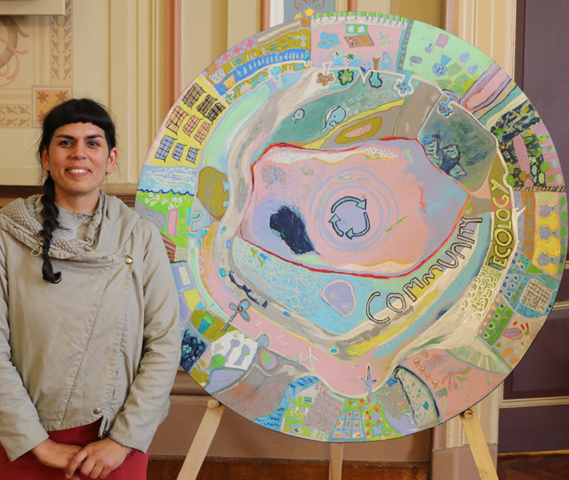While policymakers seem paralysed, money is starting to shape our energy future.

Hobart artist Selena De Carvalho with artwork produced by students at Lansdowne Crescent Primary School. PHOTO Hobart City
Earlier this year as part of its climate strategy review, Hobart City reached out to young and old residents to try to get a handle on climate change and how they envisaged it might affect those coming after them.
The response included a striking circular painting about community action, ecosystem loss and resilience, produced by schoolchildren with the help of local artist Selena De Carvalho.
The other part of the residents’ response was a collection of letters to generations yet to come. They were a mixture of the lofty and the commonplace, bits of hope, bits of trivia, wishful thinking, sentiments about trees and animals, and a good deal of anxiety, apology and regret.
The underlying sense was of people uncertain about what to say, as we find sometimes around serious illness and death. They see we need a united effort to meet a deadly threat to our future, but they also see politicians responsible for leading that effort doing all they can to avoid it.
As we have seen in Australia, climate change carries a lot of political risk. Its impact is not readily apparent and despite all the positive feelings about technology, resilience and community action, the main emerging message is a negative one.
But politics is not the only game in town, and smart leaders know when to step aside. When the alarm was raised over the Wild Boars soccer boys in a cave near Chiang Rai, the Thai government and its military might have been tempted to keep the rescue in-house and refuse outside help.
But aware of its limitations, the government opened up to foreign assistance and allowed complete freedom, even down to indemnity from future prosecution, to the cave-diving, logistical and medical experts who flew in to help. That’s what happens when people are in dire need.
Right now, all of humanity is in dire need. Experts – scientists who understand the workings of global climate – say climate change is a global emergency – as clear and present a danger as the Chiang Rai event, except that the scale is infinitely larger.
This year’s Northern Hemisphere summer has shown some ominous signs. On June 28 at Quriyat, Oman, the coolest night-time temperature was 42.6C – the highest daily minimum ever recorded anywhere, and a degree higher than Hobart’s highest-ever maximum under a blazing sun.
The World Meteorological Organization reported exceptional heat events in the western US, eastern Canada, northern Europe and northern Siberia, accompanied by wildfires in California and Siberia, heat-related deaths in Canada and drought in Europe.
Most people agree with the signs, say opinion polls. In the United States, flying in the face of Donald Trump’s disdain for the science of climate change, are poll findings that over 70 per cent of Americans think there is “solid evidence of global warming”.
Though the evidence is in place to justify a global rescue mission for our climate, it’s being met with policy paralysis. With most of the world’s people agreeing, there may yet be a way around this to achieve the massive emission reductions needed to avoid dangerous warming.
Although the global economy is facilitated by governments, it is driven by what the world’s people want to do with their money, and private spending priorities are causing whole economies to move in the direction of clean energy.
Big business is coming on board, spurred by repeated warnings to banks and insurers from international and Australian regulators, including the Bank of England and the Australian Prudential Regulation Authority, that failure to prepare for climate change puts their future at risk.
Last week’s power pricing report by the Australian Competition and Consumer Commission proposed that that for new generation projects the Turnbull government seek long-term agreements at a low fixed price, which it suggested should be around $45 to $50 a megawatt-hour.
This would effectively bring down the curtain on coal power. Treasurer Scott Morrison has said that new high-efficiency, low-emission coal power stations would have to charge twice the price paid for power from existing coal generators. Currently that’s somewhere around $80 a megawatt-hour.
Meanwhile, contract prices for electricity from new solar and wind plants have slipped below those for coal power. Wind is currently cheapest but solar, including household solar, is closing that gap. Even abolishing renewable energy targets wouldn’t change this decisive long-term trend.
People are voting with their money, and it is left for the legislators to catch up. Perhaps resources minister and long-standing coal advocate Matt Canavan is starting to understand this; he told the ABC’s Insiders at the weekend that he is not wedded to the idea of building new coal power plants.
That’s a sensible attitude, because the smart money says that the only new plants, now and looking ahead, will be gas or renewable ones. Those worried Hobart citizens should not not let leadership failure discourage them, because other forces are at work.
